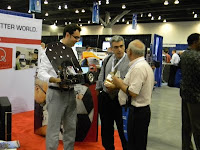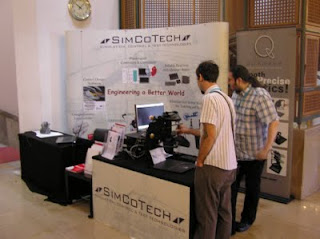
I've been going to our two major engineering control conferences for most of the nine years that I've been at Quanser. The American Society for Engineering Education Annual Conference and Exposition (
ASEE) and the American Control Conference (
ACC) represent a great sample of Quanser's customers. The ASEE is a tradeshow and conference on engineering education, while ACC is a conference that focuses on control engineering and research. Since Quanser is a company devoted to improving engineering education, and since controls engineering being at our core, it's a great fit.

When I first joined Quanser it was a small but growing global company and those of us who attended tradeshows were used to wearing many hats. One of my "hats" was to represent the company at these two major conferences. As the years passed and Quanser grew, I moved aside to allow more recent R&D and Sales Engineers to attend and get a chance to meet and interact with our customers.
I have many fond memories of both conferences. In the early days, there was the excitement (and sweat) of constructing the booth and setting up our experiments for display. We weren't too well known back then but our experiments would really captivate passersby and serve to break the ice and start some great conversations. The most rewarding aspect of this experience for me was understanding our customers' point of view, and seeing how well they actually utilized our solutions. I'd be talking all day and by the time both conferences were done, so was my voice. But it was worth it. We'd come back to the office with a long list of follow ups and an even longer list of product ideas and improvements.
But here it was 2011, 5 years since my last ACC/ASEE

, so it was time for me to get back to the shows! I flew into Vancouver, where this year's ASEE was being held, and made my way into the exhibit hall. To my amazement, I was surrounded by Quanser "Q's" from the moment I walked in. The Quanser flag greeted me as I walked towards the hall, the internet station was sponsored by Quanser (and decorated with our "Q's") and as I walked into the exhibits I could follow the Quanser "Q's" on the floor that would lead me directly to the Quanser Innovation Hub! This wasn't the ASEE that I remembered! What's more, the booth was already in place and the Quanser engineers who had arrived before me had already set up all the experiments - there wasn't much left for me to do!
As the exhibit hall opened to the delegates, we

were overwhelmed by a mass of attendees (I'm sure the free breakfast helped). I was in tradeshow mode again, the helicopter was spinning, the pendulum was inverting and the flexible link was flexing - we were ready to put on a show. Although we had 4 people at the booth, we were all engaged with professors discussing a variety of topics, everything from our new ABET-aligned curriculum to the exciting Unmanned Vehicle we were demonstrating at the Innovation Hub. The discussions I was having were different from what I remember - I was no long explaining 'who' we were to prospective clients, I was discussing existing clients' experiences with Quanser labs.
There were still a handful of professors that hadn't heard of Quanser (with all the "Q's", they will not easily forget), but the majority of my time was spent discussing the implementation of a Quanser lab at a university and listening to feedback from professors who have already deployed a Quanser lab.
Strangely, after the initial onslaught of delegates, we

found that the exhibit hall traffic slowed down considerably. With seven Quanser delegates at the booth and Innovation Hub, the slow times were a little boring. I noticed that something had changed over the years, but wasn't sure what. Were the conference talks and seminars more interesting? Was Vancouver too seductive of a city to keep delegates in an exhibit hall? Or was personal digital technology now enabling people to "kill" 10 minutes by flipping through their apps or checking their email as opposed to walking the show floor? I didn't have the answer, but I knew something was different.
I left the ASEE Conference with mixed emotions. On the one hand I was a little disapointed that I did not get to talk to as many people as I had hoped, but on the other hand I was filled with pride at seeing the Quanser logo blanket at the ASEE and hearing the great feedback from our customers about all the successful Quanser installations.
I then made my way to San Francisco to join the

Quanser team setting up for the ACC. Quanser had six delegates at this conference, so I arrived at our booth to find everything was already up and running - nothing to setup again! The ACC, in contrast to the ASEE, is an academic conference focused on cutting edge research in the fields of automation and controls. It was exciting to see and hear about all the new areas of research, specifically in the areas that Quanser is also focusing on, such as unmanned vehicle systems, smart energy, and intelligent systems. Where the ASEE focuses on educating the undergraduate engineer through hands-on learning, the ACC focuses on new, emerging technique to advance the study of controls into new fields.
As at the ASEE Conference, I was pleasantly surprised that I was no longer explaining "who" Quanser is but discussing "how" we could collaborate with professors to further enable their research ambitions or assist with a graduate student's thesis. The conference sessions were very interesting and with six delegates, I found I had plenty of time to attend more talks and experience the various specialties that are emerging in Controls Engineering. During the conference breaks, the 1200+ delegates would swarm the exhibit area (thanks in part to the free coffee and food). That was where we would engage in discussions and talks. At some points it was so busy; it was difficult to move around our booth!
By the end of the conference, I again was left with

mixed emotions. The excitement of introducing our solutions and research tools to new prospective clients wasn't completely fulfilled but the satisfaction of hearing about a successful installation or taking in presentation that discusses research in collaboration with Quanser was definitely gratifying. I again got the sense though that the new handheld and connectivity technologies took away from the face-to-face discussions. It is simpler, easier and currently more natural for someone to fill the time between talks on their iPhone instead of talking to an exhibitor or another delegate.
I left the tradeshows in much better shape than I remember from the previous shows - my voice wasn't hoarse and my feet didn't hurt, but I wasn't as fulfilled by the experience as I had expected. Was it my romantic perception of days gone by or had the nature of these conferences actually changed? I think it was a little of both. As technology changes, academic conferences and gatherings will also undoubtedly change. That means our approach and expectations at these conferences must change and adapt as well. Maybe next year will be a good time to launch a Quanser App!
- Paul Karam -










